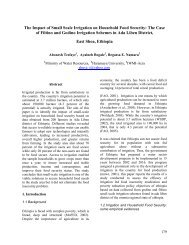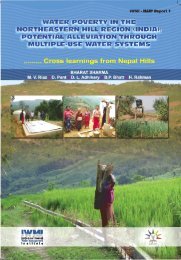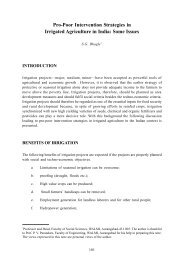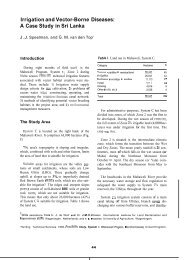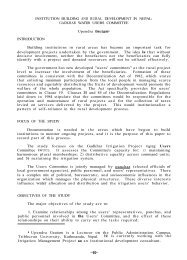A Case Study from System H, Sri Lanka
A Case Study from System H, Sri Lanka
A Case Study from System H, Sri Lanka
- No tags were found...
Create successful ePaper yourself
Turn your PDF publications into a flip-book with our unique Google optimized e-Paper software.
10 Project Description of Sysfem HThe distributary channels, which takeoff <strong>from</strong> the main andbranch cf+ls, arc designedto supply the peakrequirementof all the field channel turnouts simultaneously (Figure 6). The control structures at the heads of distributary channelscan be used to control and measure the discharge. Issues to the field channel are <strong>from</strong> the distributary channel, and thedischarge <strong>from</strong> the field channel is always 1 cusec (0.0283 cumecs, or 28.32 liters/w). A single field channel serves anarea of between 12-15 allotments of 1 ha each on average. The water has to be issued into each field channel for apredetermined period, depending on the quantity needed, which in turn depends on the soil type and crop. The intentionwas that the field channel water would be delivered to two farms at a time. each receiving In a cusec (0.0142 cumecs).TheouUetstoindividualfarmsconsistof6-inch-diameter(15.24cm)pipeswithaheadcontroldivisionbox. The turnoutsmcm to the field channel is provided with a screw-operated iron sliding gate with a weir to measure the discharge.General AspectThe Resident Project Manager, HS is in overall charge of development activities for around 13500 acres (5,465 ha)of irrigable land, and this area is divided into 3 blocks each of 4500 acres (1,822 ha). These blocks are bhken down into24 units consisting of 200-250 families. A unit manager is responsible for his unit and is helped by a field assistant inagriculture extension. This system is adopted in other areas in <strong>System</strong> H as well.Water Management AspectIn <strong>System</strong> H, an irrigation engineer is responsible for irrigation water management within the administration block.An engineering assistant is in charge of water distribution for an irrigation block containing two to three units. Theirrigationengineer functionsunder theguidanceof apmjectirrigationengineeror theDeputy Resident hoject Manager,who is the project-level officer responsible to the Resident hoject Manager for water dislribution in the entire project.There were no irrigation engineas at block level in the H5 area, and the 10 engineering assistants covering all tenirrigationblocks411-421 (except416)functioneddirectly undertheguidanceoftheRojectIrrigationEngineerforwatermanagement operation (Figure 7).POSTCONSTRUCTION SETTLEMENT ACTIVITIES AND TRAJNING PROGRAMS FOROFFICERS AND FARMERS ON WATER MANAGEMENTSettler Welfare/CareThe total number of irrigable lots alienated and developed for settlement in the H5 area is 5,500. The communitydevelopment unit of the project was charged with the responsibility of village programs dealing with a) religious andcultural activities, b) environmental sanitation, c) community wells for drinking water, a) nutrition andmother-and-childhealth, e) day-care centers, 9 sports, g) youth and children, h) women, i) family planning, and j) educationaI activities.It was recognized that unless the community was organized into cohesive pups, community development will nottake place. Communities live in hamlets and this is where they should be organized for the above programs. However,coordination with water management units will be effective at turnout levels, and not at the hamlet level. Since fieldchannelfarmersliveinhamle$(onaveragesixfieldchannelgroupsperhamlet),thefieldchannelo~~tionoffarmerswm able to form small agricultural units within the hamlet.



